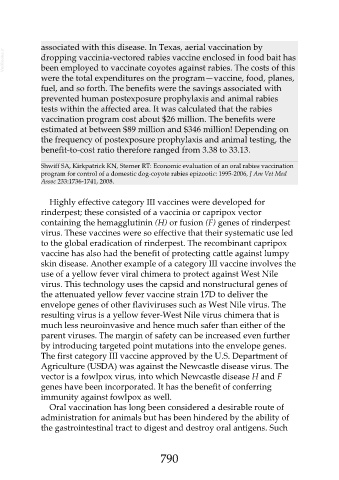Page 790 - Veterinary Immunology, 10th Edition
P. 790
associated with this disease. In Texas, aerial vaccination by
VetBooks.ir dropping vaccinia-vectored rabies vaccine enclosed in food bait has
been employed to vaccinate coyotes against rabies. The costs of this
were the total expenditures on the program—vaccine, food, planes,
fuel, and so forth. The benefits were the savings associated with
prevented human postexposure prophylaxis and animal rabies
tests within the affected area. It was calculated that the rabies
vaccination program cost about $26 million. The benefits were
estimated at between $89 million and $346 million! Depending on
the frequency of postexposure prophylaxis and animal testing, the
benefit-to-cost ratio therefore ranged from 3.38 to 33.13.
Shwiff SA, Kirkpatrick KN, Sterner RT: Economic evaluation of an oral rabies vaccination
program for control of a domestic dog-coyote rabies epizootic: 1995-2006, J Am Vet Med
Assoc 233:1736-1741, 2008.
Highly effective category III vaccines were developed for
rinderpest; these consisted of a vaccinia or capripox vector
containing the hemagglutinin (H) or fusion (F) genes of rinderpest
virus. These vaccines were so effective that their systematic use led
to the global eradication of rinderpest. The recombinant capripox
vaccine has also had the benefit of protecting cattle against lumpy
skin disease. Another example of a category III vaccine involves the
use of a yellow fever viral chimera to protect against West Nile
virus. This technology uses the capsid and nonstructural genes of
the attenuated yellow fever vaccine strain 17D to deliver the
envelope genes of other flaviviruses such as West Nile virus. The
resulting virus is a yellow fever-West Nile virus chimera that is
much less neuroinvasive and hence much safer than either of the
parent viruses. The margin of safety can be increased even further
by introducing targeted point mutations into the envelope genes.
The first category III vaccine approved by the U.S. Department of
Agriculture (USDA) was against the Newcastle disease virus. The
vector is a fowlpox virus, into which Newcastle disease H and F
genes have been incorporated. It has the benefit of conferring
immunity against fowlpox as well.
Oral vaccination has long been considered a desirable route of
administration for animals but has been hindered by the ability of
the gastrointestinal tract to digest and destroy oral antigens. Such
790

